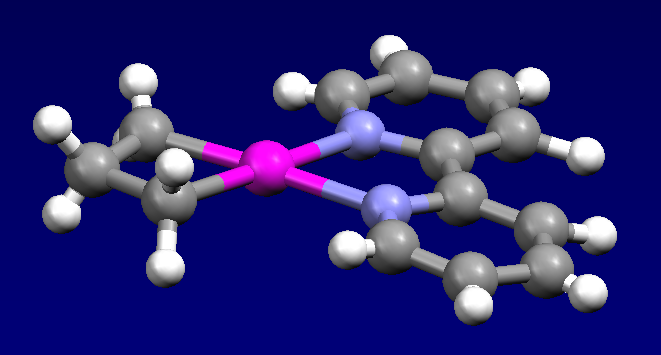Metallacycle on:
[Wikipedia]
[Google]
[Amazon]
 In
In
 Many compounds containing metals in rings are known, for example
Many compounds containing metals in rings are known, for example

 Metallacyclobutane intermediates are involved in the
Metallacyclobutane intermediates are involved in the
 Metallacycles often arise by cyclization of arene-containing donor ligands, e.g. aryl phosphines and amines. An early example is the cyclization of IrCl(PPh3)3 to give the corresponding Ir(III) hydride containing a four-membered IrPCC ring. Palladium(II) and platinum(II) have long been known to ortho-metalate aromatic ligands such as azobenzene, benzylamines, and 2-phenylpyridines. These reactions are strongly influenced by substituent effects, including the Thorpe-Ingold effect. Ligands that lack aryl substituents will sometimes cyclometalate via activation of methyl groups, an early example being the internal oxidative addition of methylphosphine ligands. Metallacycle formation interferes with intermolecular C-H activation processes. For this reason, specialized "
Metallacycles often arise by cyclization of arene-containing donor ligands, e.g. aryl phosphines and amines. An early example is the cyclization of IrCl(PPh3)3 to give the corresponding Ir(III) hydride containing a four-membered IrPCC ring. Palladium(II) and platinum(II) have long been known to ortho-metalate aromatic ligands such as azobenzene, benzylamines, and 2-phenylpyridines. These reactions are strongly influenced by substituent effects, including the Thorpe-Ingold effect. Ligands that lack aryl substituents will sometimes cyclometalate via activation of methyl groups, an early example being the internal oxidative addition of methylphosphine ligands. Metallacycle formation interferes with intermolecular C-H activation processes. For this reason, specialized "
 In
In organometallic chemistry
Organometallic chemistry is the study of organometallic compounds, chemical compounds containing at least one chemical bond between a carbon atom of an organic molecule and a metal, including alkali, alkaline earth, and transition metals, and s ...
, a metallacycle is a derivative of a carbocyclic compound wherein a metal has replaced at least one carbon
Carbon () is a chemical element with the symbol C and atomic number 6. It is nonmetallic and tetravalent—its atom making four electrons available to form covalent chemical bonds. It belongs to group 14 of the periodic table. Carbon ma ...
center; this is to some extent similar to heterocycle
A heterocyclic compound or ring structure is a cyclic compound that has atoms of at least two different elements as members of its ring(s). Heterocyclic chemistry is the branch of organic chemistry dealing with the synthesis, properties, and ...
s. Metallacycles appear frequently as reactive intermediate
In chemistry
Chemistry is the scientific study of the properties and behavior of matter. It is a natural science that covers the elements that make up matter to the compounds made of atoms, molecules and ions: their composition, s ...
s in catalysis
Catalysis () is the process of increasing the rate of a chemical reaction by adding a substance known as a catalyst (). Catalysts are not consumed in the reaction and remain unchanged after it. If the reaction is rapid and the catalyst recyc ...
, e.g. olefin metathesis
Olefin metathesis is an organic reaction that entails the redistribution of fragments of alkenes (olefins) by the scission and regeneration of carbon-carbon double bonds. Because of the relative simplicity of olefin metathesis, it often create ...
and alkyne trimerization
In organic chemistry, an alkyne trimerisation is a +2+2nbsp;cycloaddition reaction in which three alkyne units () react to form a benzene ring. The reaction requires a metal catalyst. The process is of historic interest as well as being applica ...
. In organic synthesis
Organic synthesis is a special branch of chemical synthesis and is concerned with the intentional construction of organic compounds. Organic molecules are often more complex than inorganic compounds, and their synthesis has developed into one o ...
, directed ortho metalation
Directed ortho metalation (DoM) is an adaptation of electrophilic aromatic substitution in which electrophiles attach themselves exclusively to the ortho- position of a direct metalation group or DMG through the intermediary of an aryllithium co ...
is widely used for the functionalization of arene rings via C-H activation. One main effect that metallic atom substitution on a cyclic carbon compound is distorting the geometry due to the large size of typical metals.
Nomenclature
Typically, metallacycles are cyclic compounds with two metal carbon bonds. Many compounds containing metals in rings are known, for example
Many compounds containing metals in rings are known, for example chelate
Chelation is a type of bonding of ions and molecules to metal ions. It involves the formation or presence of two or more separate coordinate bonds between a polydentate (multiple bonded) ligand and a single central metal atom. These ligands are ...
rings. Usually, such compounds are not classified as metallacycles, but the naming conventions are not rigidly followed. Within the area of coordination chemistry
A coordination complex consists of a central atom or ion, which is usually metallic and is called the ''coordination centre'', and a surrounding array of bound molecules or ions, that are in turn known as ''ligands'' or complexing agents. Man ...
and supramolecular chemistry
Supramolecular chemistry refers to the branch of chemistry concerning chemical systems composed of a discrete number of molecules. The strength of the forces responsible for spatial organization of the system range from weak intermolecular forces ...
, examples include metallacrowns, metallacryptands, metallahelices, and molecular wheels.
Classes of metallacycles
Metal-alkene complexes can be viewed as the smallest metallacycles, but they usually are not classified as metallacycles. In theDewar–Chatt–Duncanson model
The Dewar–Chatt–Duncanson model is a model in organometallic chemistry that explains the chemical bonding in transition metal alkene complexes. The model is named after Michael J. S. Dewar, Joseph Chatt and L. A. Duncanson.
The alkene donat ...
, one resonance structure for the M(η2-alkene) center is the metallacyclopropane.

Metallacyclobutanes
The parent metallacyclobutane has the formula LnM(CH2)3 where L is a ligand attached to M. A stable example is ( PPh3)2Pt(CH2)3. The first example was prepared by oxidative addition of cyclopropane to platinum. Metallacyclobutane intermediates are involved in the
Metallacyclobutane intermediates are involved in the alkene metathesis
Olefin metathesis is an organic reaction that entails the redistribution of fragments of alkenes (olefins) by the scission and regeneration of carbon-carbon double bonds. Because of the relative simplicity of olefin metathesis, it often create ...
and in the oligomerization and dimerization of ethylene. In alkene metathesis, the Chauvin mechanism invokes the attack of an alkene at an electrophilic metal carbene catalyst. This work helped to validate the Chauvin mechanism for olefin metathesis.
Metallacyclopentadienes and metallabenzenes
The parent metallacyclopentadiene has the formula LnM(CH)4. Most arise from the coupling of twoalkyne
\ce
\ce
Acetylene
\ce
\ce
\ce
Propyne
\ce
\ce
\ce
\ce
1-Butyne
In organic chemistry, an alkyne is an unsaturated hydrocarbon containing at least one carbon—carbon triple bond. The simplest acyclic alkynes with only one triple bond and n ...
s at a low valent metal centers such as derivatives of Co(I) and Zr(II). Late metal derivatives (Co, Ni) are intermediates in the metal-catalysed trimerization of alkynes to arenes. Early metal derivatives, i.e. derivatives of Ti and Zr, are used stoichiometrically. For example, the zirconacyclopentadiene Cp2ZrC4Me4 is a useful carrier for C4Me42−. Some of the oldest metallacycles are the ferroles, which are dimetallacyclopentadiene complexes of the formula Fe2(C2R4)(CO)6. They are derived from coupling of alkynes as well as from the desulfurization of thiophenes.
The parent metallacyclobenzenes have the formula LnM(CH)5. They can be viewed as derivatives of benzene wherein a CH center has been replaced by a transition metal complex
A coordination complex consists of a central atom or ion, which is usually metallic and is called the ''coordination centre'', and a surrounding array of bound molecules or ions, that are in turn known as ''ligands'' or complexing agents. Many ...
.
Metallacyclopentanes
The parentmetallacyclopentane
In organometallic chemistry, metallacyclopentanes are compounds with the formula LnM(CH2)4 (Ln = ligands, and M = metal). They are a type of metallacycle. Metallacyclopentanes are intermediates in some metal-catalysed reactions in homogeneous cata ...
has the formula LnM(CH2)4. Such compounds are intermediates in the metal catalysed dimerization, trimerization, and tetramerization of ethylene to give but-1-ene
1-Butene (or 1-Butylene) is the organic compound with the formula CH3CH2CH=CH2. It is a colorless gas that is easily condensed to give a colorless liquid. It is classified as a linear alpha-olefin. It is one of the isomers of butene (butylene). ...
, hex-1-ene and oct-1-ene
1-Octene is an organic compound with a formula CH2CHC6H13. The alkene is classified as a higher olefin and alpha-olefin, meaning that the double bond is located at the alpha (primary) position, endowing this compound with higher reactivity and ...
, respectively. Metallacyclopentanes are invoked as intermediates in the evolution of heterogeneous alkene metathesis
Olefin metathesis is an organic reaction that entails the redistribution of fragments of alkenes (olefins) by the scission and regeneration of carbon-carbon double bonds. Because of the relative simplicity of olefin metathesis, it often create ...
catalysts from ethylene and metal oxides. Metallacyclopentane intermediates are proposed to isomerize to metallacyclobutanes, which then eliminate propylene giving the alkylidene.
Ortho-metalation
 Metallacycles often arise by cyclization of arene-containing donor ligands, e.g. aryl phosphines and amines. An early example is the cyclization of IrCl(PPh3)3 to give the corresponding Ir(III) hydride containing a four-membered IrPCC ring. Palladium(II) and platinum(II) have long been known to ortho-metalate aromatic ligands such as azobenzene, benzylamines, and 2-phenylpyridines. These reactions are strongly influenced by substituent effects, including the Thorpe-Ingold effect. Ligands that lack aryl substituents will sometimes cyclometalate via activation of methyl groups, an early example being the internal oxidative addition of methylphosphine ligands. Metallacycle formation interferes with intermolecular C-H activation processes. For this reason, specialized "
Metallacycles often arise by cyclization of arene-containing donor ligands, e.g. aryl phosphines and amines. An early example is the cyclization of IrCl(PPh3)3 to give the corresponding Ir(III) hydride containing a four-membered IrPCC ring. Palladium(II) and platinum(II) have long been known to ortho-metalate aromatic ligands such as azobenzene, benzylamines, and 2-phenylpyridines. These reactions are strongly influenced by substituent effects, including the Thorpe-Ingold effect. Ligands that lack aryl substituents will sometimes cyclometalate via activation of methyl groups, an early example being the internal oxidative addition of methylphosphine ligands. Metallacycle formation interferes with intermolecular C-H activation processes. For this reason, specialized "pincer ligand
In chemistry, a transition metal pincer complex is a type of coordination complex with a pincer ligand. Pincer ligands are chelating agents that binds tightly to three adjacent coplanar sites in a meridional configuration. The inflexibility of ...
s" ligands have been developed that resist ortho-metalation.
References
{{Reflist Organometallic chemistry Heterocyclic compounds